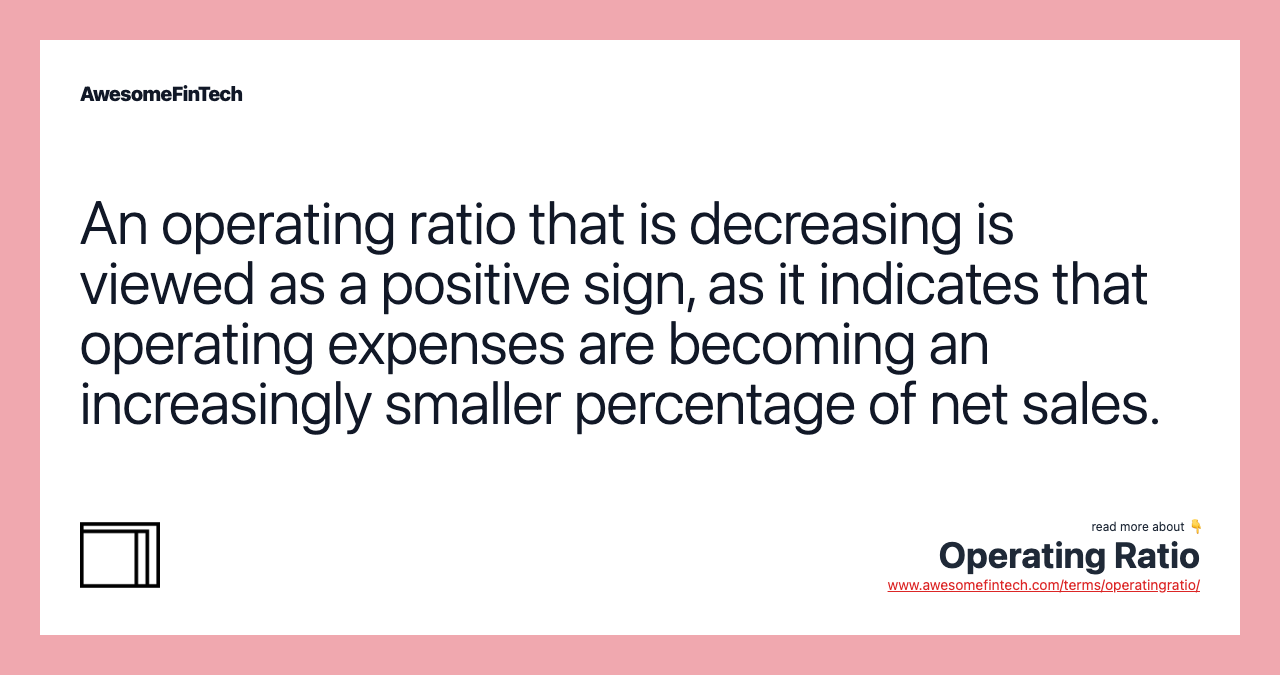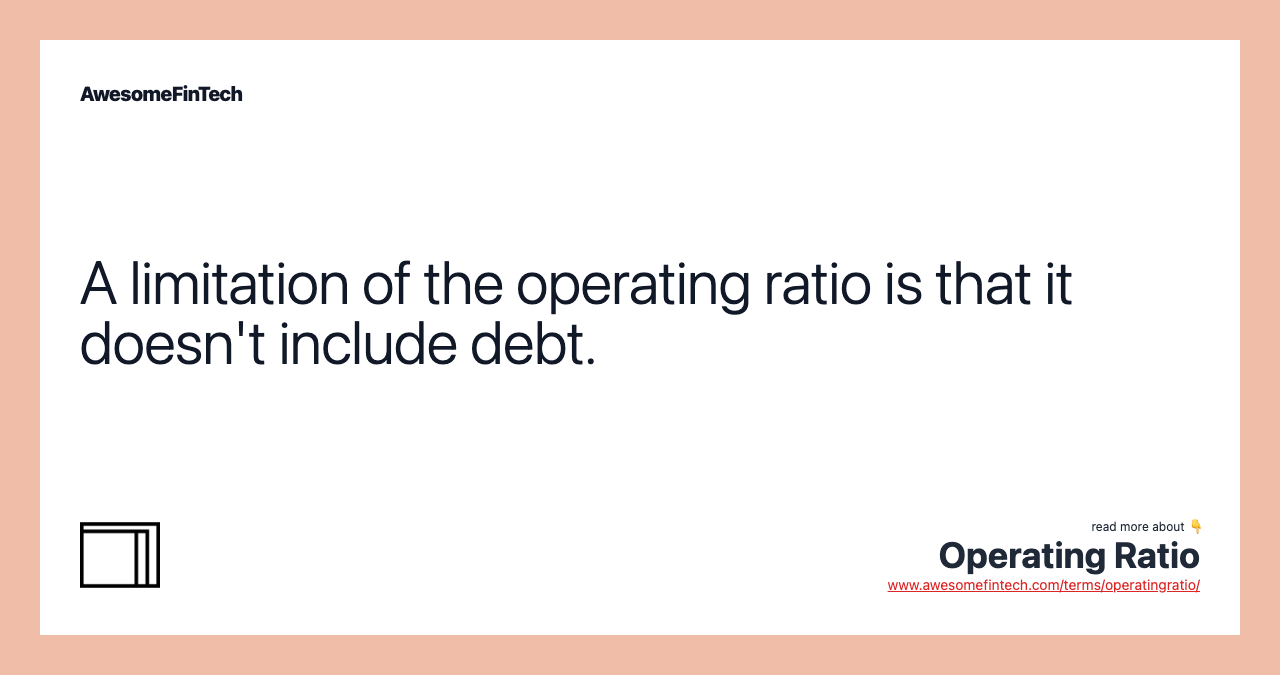Operating Ratio
The operating ratio shows the efficiency of a company's management by comparing the total operating expense (OPEX) of a company to net sales. 2. Find total operating expenses, which should be farther down the income statement. 3. Add total operating expenses and cost of goods sold or COGS and plug the result into the numerator of the formula. 4. Divide the sum of operating expenses and COGS by the total net sales. 5. Please note that some companies include the cost of goods sold as part of operating expenses while other companies list the two costs separately. Investment analysts have many ways of analyzing company performance. The operating ratio is calculated as follows: $46.59 billion / $59.68 billion, which equals 0.78 or 78%. The operating ratio for Apple means that 78% of the company's net sales are operating expenses. The calculation for the operating ratio is: O p e r a t i n g R a t i o \= O p e r a t i n g E x p e n s e s \+ C o s t o f G o o d s S o l d N e t S a l e s Operating\\, Ratio = \\frac{Operating\\, Expenses\\, +\\, Cost\\, of\\, Goods\\, Sold}{Net\\, Sales} OperatingRatio\=NetSalesOperatingExpenses+CostofGoodsSold 1. The operating ratio shows the efficiency of a company's management by comparing the total operating expense (OPEX) of a company to net sales.

What Is the Operating Ratio?
The operating ratio shows the efficiency of a company's management by comparing the total operating expense (OPEX) of a company to net sales. The operating ratio shows how efficient a company's management is at keeping costs low while generating revenue or sales. The smaller the ratio, the more efficient the company is at generating revenue vs. total expenses.



How the Operating Ratio Works
The calculation for the operating ratio is:
O p e r a t i n g R a t i o = O p e r a t i n g E x p e n s e s + C o s t o f G o o d s S o l d N e t S a l e s Operating\, Ratio = \frac{Operating\, Expenses\, +\, Cost\, of\, Goods\, Sold}{Net\, Sales} OperatingRatio=NetSalesOperatingExpenses+CostofGoodsSold
- From a company's income statement take the total cost of goods sold, which can also be called cost of sales.
- Find total operating expenses, which should be farther down the income statement.
- Add total operating expenses and cost of goods sold or COGS and plug the result into the numerator of the formula.
- Divide the sum of operating expenses and COGS by the total net sales.
- Please note that some companies include the cost of goods sold as part of operating expenses while other companies list the two costs separately.
What Does the Operating Ratio Tell You?
Investment analysts have many ways of analyzing company performance. Because it concentrates on core business activities, one of the most popular ways to analyze performance is by evaluating the operating ratio. Along with return on assets and return on equity, it is often used to measure a company's operational efficiency. It is useful to track the operating ratio over a period of time to identify trends in operational efficiency or inefficiency.
An operating ratio that is going up is viewed as a negative sign, as this indicates that operating expenses are increasing relative to sales or revenue. Conversely, if the operating ratio is falling, expenses are decreasing, or revenue is increasing, or some combination of both. A company may need to implement cost controls for margin improvement if its operating ratio increases over time.
Components of the Operating Ratio
Operating expenses are essentially all expenses except taxes and interest payments. Also, companies will typically not include non-operating expenses in the operating ratio.
Operating expenses are the costs associated with running the business that is not directly tied to the production of the product or service. Operating expenses include overhead expenses such as sales, general, and administrative costs. An example of overhead might be the expense of the corporate office for a company because although necessary, it's not directly tied to production. Operating expenses can include:
Operating expenses can also include the cost of goods sold, which are the expenses directly tied to the production of goods and services. However, most companies separate operating expenses from the cost of goods sold. Therefore, the two costs must be added together to form the numerator in the operating ratio calculation. Cost of goods sold can include the following:
Revenue or net sales is the top line of the income statement and is the amount of money a company generates before expenses are taken out. Some companies list revenue as net sales because they have returns of merchandise from customers whereby they credit the client back, which is deducted from revenue.
All of these line items are listed on the income statement. Companies must clearly state which expenses are operational and which are designated for other uses.
Example of the Operating Ratio
Below is the income statement for Apple Inc. (AAPL) as of June 27, 2020, according to their Q3 report.
The operating ratio for Apple means that 78% of the company's net sales are operating expenses. Apple's operating ratio must be examined over several quarters to get a sense of whether the company is managing its operating costs effectively. Also, investors can monitor operating expenses and cost of goods sold (or cost of sales) separately to determine whether costs are either increasing or decreasing over time.
Operating Ratio vs. Operating Expense Ratio
The operating expense ratio (OER) is used in the real estate industry and is a measurement of what it costs to operate a property compared to the income that the property generates. It is calculated by dividing a property's operating expense (minus depreciation) by its gross operating income. The OER is used for comparing the expenses of similar properties.
On the other hand, the operating ratio is the comparison of a company's total expenses compared to the revenue or net sales generated. The operating ratio is used for company analysis in various industries while the OER is used in the real estate industry.
Limitations of the Operating Ratio
A limitation of the operating ratio is that it doesn't include debt. Some companies take on a great deal of debt, meaning they are committed to paying large interest payments, which are not included in the operating expenses figure of the operating ratio. Two companies can have the same operating ratio with vastly different debt levels, so it is important to compare debt ratios before coming to any conclusions.
As with any financial metric, the operating ratio should be monitored over multiple reporting periods to determine if a trend is present. Companies can sometimes cut costs in the short term, thus inflating their earnings temporarily. Investors must monitor costs to see if they're increasing or decreasing over time while also comparing those results to the performance of revenue and profit.
It's also important to compare the operating ratio with other firms in the same industry. If a company has a higher operating ratio than its peer average, it may indicate inefficiency and vice versa. Finally, as with all ratios, it should be used as part of a full ratio analysis, rather than in isolation.
Related terms:
Berry Ratio
The Berry ratio measures a company's gross profit to operating expenses. Used in transfer pricing methods, this ratio is a financial indicator. read more
Cost of Goods Sold – COGS
Cost of goods sold (COGS) is defined as the direct costs attributable to the production of the goods sold in a company. read more
Earnings Before Interest and Taxes (EBIT) & Formula
Earnings before interest and taxes is an indicator of a company's profitability and is calculated as revenue minus expenses, excluding taxes and interest. read more
Income Statement : Uses & Examples
An income statement is one of the three major financial statements that reports a company's financial performance over a specific accounting period. read more
Net Profit Margin
Expressed as a percentage, the net profit margin shows how much of each dollar collected by a company as revenue translates into profit. read more
Net Loss
A net loss is when expenses exceed the income or total revenue produced for a given period of time and is sometimes called a net operating loss (NOL). read more
Net Sales
Net sales are the result of gross sales minus returns, allowances, and discounts. They are a factor in gross profit but do not include costs of goods sold. read more
Non-Operating Expense
A non-operating expense is an expense incurred by a business that is unrelated to its core operations. read more
Operating Cost
Operating costs are expenses associated with normal day-to-day business operations. read more
Operating Expense Ratio (OER)
The operating expense ratio (OER) is defined as a measurement of the cost to operate a piece of property compared to the income brought in by the property. read more